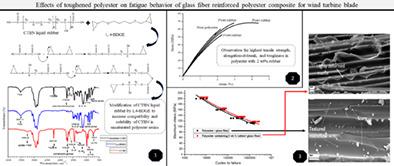当前位置:
X-MOL 学术
›
Polym. Compos.
›
论文详情
Our official English website, www.x-mol.net, welcomes your feedback! (Note: you will need to create a separate account there.)
Effects of toughened polyester on fatigue behavior of glass fiber reinforced polyester composite for wind turbine blade
Polymer Composites ( IF 5.2 ) Pub Date : 2020-09-19 , DOI: 10.1002/pc.25808 Mohammad Amin Mousavi Khorasani 1 , samaneh sahebian 2 , Ahad Zabett 3
Polymer Composites ( IF 5.2 ) Pub Date : 2020-09-19 , DOI: 10.1002/pc.25808 Mohammad Amin Mousavi Khorasani 1 , samaneh sahebian 2 , Ahad Zabett 3
Affiliation

|
Cured unsaturated polyester resins are often highly brittle. In this paper, to improve fatigue life of the glass fiber‐reinforced polyester composite (GFRP) used in the wind turbine blade, the unsaturated polyester resin was toughened by 2 wt% liquid carboxyl‐terminated butadiene acrylonitrile (CTBN) copolymer. CTBN liquid rubber has acidic OH of the carboxylic group, which causes incompatibility and poor solubility of CTBN in unsaturated polyester resins. In this study, to increase compatibility and solubility of CTBN liquid rubber in unsaturated polyester resins, 1,4‐Butanediol diglycidyl ether (1,4‐BDGE) was selected to react with carboxylic group of the CTBN liquid rubber which converted to ester functional group. The reactions between epoxy groups of 1,4‐BDGE and carboxyl groups of CTBN were investigated by Fourier‐transform infrared (FTIR) spectroscopy. Four polyester samples were prepared by mixing unsaturated polyester with 0 to 3 wt% of modified CTBN. Tensile tests of polymer samples have been performed to observe the effect of modified CTBN additive. According to the results of the tensile test, the highest tensile strength, elongation‐at‐break, and modulus of toughness were observed in polyester with 2 wt% rubber. Two polyester/glass fiber composite samples with and without 2 wt% rubber were prepared by the vacuum infusion process (VIP) and subjected to fatigue behavior analysis. According to the results of the static tension test, the same value of tensile strength was observed in both composites. The obtained tension‐tension fatigue results (R = 0.1) showed a reduction in maximum stress level enhanced the fatigue life improvement for the samples with 2 wt% rubber due to the increased toughness of the composite matrix. Examining the fracture surfaces of the specimens after fatigue tests, it was revealed that failure of the polyester containing 2 wt% rubber/glass fiber occurred at the interface, while the specimens without rubber showed that failure did not occur at the fiber/matrix interface.
中文翻译:

增韧聚酯对风力涡轮机叶片玻璃纤维增强聚酯复合材料疲劳性能的影响
固化的不饱和聚酯树脂通常很脆。在本文中,为了提高风力涡轮机叶片中使用的玻璃纤维增强聚酯复合材料(GFRP)的疲劳寿命,不饱和聚酯树脂通过2 wt%的液体羧基封端的丁二烯丙烯腈(CTBN)共聚物进行了增韧。CTBN液态橡胶具有酸性羧基的OH,这会导致CTBN在不饱和聚酯树脂中的不相容性和较差的溶解性。在这项研究中,为了提高CTBN液态橡胶在不饱和聚酯树脂中的相容性和溶解性,选择1,4-丁二醇二缩水甘油醚(1,4-BDGE)与CTBN液态橡胶的羧基反应,该羧基转化为酯官能团。用傅立叶变换红外光谱(FTIR)研究了1,4-BDGE的环氧基与CTBN的羧基之间的反应。通过将不饱和聚酯与0至3 wt%的改性CTBN混合来制备四个聚酯样品。已经进行了聚合物样品的拉伸试验以观察改性的CTBN添加剂的作用。根据拉伸试验的结果,最高的拉伸强度,断裂伸长率,在含2wt%橡胶的聚酯中观察到韧性和韧性模量。通过真空灌注工艺(VIP)制备了两种含/不含2 wt%橡胶的聚酯/玻璃纤维复合材料样品,并进行了疲劳行为分析。根据静态拉伸试验的结果,在两种复合材料中观察到相同的拉伸强度值。获得的拉伸-拉伸疲劳结果(R = 0.1)表明,由于复合基质的韧性提高,最大应力水平的降低增强了含2 wt%橡胶的样品的疲劳寿命,从而提高了疲劳寿命。检查疲劳试验后的试样断裂表面,发现在界面处发生了含有2 wt%橡胶/玻璃纤维的聚酯的破坏,
更新日期:2020-09-19
中文翻译:

增韧聚酯对风力涡轮机叶片玻璃纤维增强聚酯复合材料疲劳性能的影响
固化的不饱和聚酯树脂通常很脆。在本文中,为了提高风力涡轮机叶片中使用的玻璃纤维增强聚酯复合材料(GFRP)的疲劳寿命,不饱和聚酯树脂通过2 wt%的液体羧基封端的丁二烯丙烯腈(CTBN)共聚物进行了增韧。CTBN液态橡胶具有酸性羧基的OH,这会导致CTBN在不饱和聚酯树脂中的不相容性和较差的溶解性。在这项研究中,为了提高CTBN液态橡胶在不饱和聚酯树脂中的相容性和溶解性,选择1,4-丁二醇二缩水甘油醚(1,4-BDGE)与CTBN液态橡胶的羧基反应,该羧基转化为酯官能团。用傅立叶变换红外光谱(FTIR)研究了1,4-BDGE的环氧基与CTBN的羧基之间的反应。通过将不饱和聚酯与0至3 wt%的改性CTBN混合来制备四个聚酯样品。已经进行了聚合物样品的拉伸试验以观察改性的CTBN添加剂的作用。根据拉伸试验的结果,最高的拉伸强度,断裂伸长率,在含2wt%橡胶的聚酯中观察到韧性和韧性模量。通过真空灌注工艺(VIP)制备了两种含/不含2 wt%橡胶的聚酯/玻璃纤维复合材料样品,并进行了疲劳行为分析。根据静态拉伸试验的结果,在两种复合材料中观察到相同的拉伸强度值。获得的拉伸-拉伸疲劳结果(R = 0.1)表明,由于复合基质的韧性提高,最大应力水平的降低增强了含2 wt%橡胶的样品的疲劳寿命,从而提高了疲劳寿命。检查疲劳试验后的试样断裂表面,发现在界面处发生了含有2 wt%橡胶/玻璃纤维的聚酯的破坏,


























 京公网安备 11010802027423号
京公网安备 11010802027423号